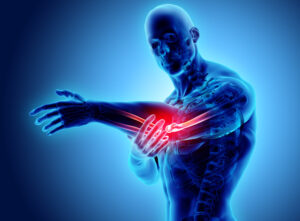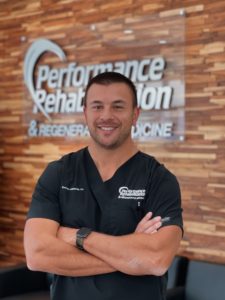Stem Cell Therapy
One of the fastest growing sectors of non-surgical orthopedic treatment is the exciting new subspecialty of Regenerative Medicine, which is more descriptively referred to as “ortho-biologics.” The deconstructed term relates to, “ortho” referring to orthopedic medicine and “biologics”, relating to a substance derived from human sources (usually stem cells or growth factors) to treat diseased or dysfunctional tissue. Adult stem cell therapy is one of the cutting-edge procedures we do here at Performance Rehabilitation and Regenerative Medicine.
Anyone who 
available to elite athletes. Fortunately, this technology is now available in a limited number of medical practices for both athletes and non-athletes that desire conservative, non-surgical solutions to pain reduction and to return to full function. The following information will provide some fundamental information regarding the science, application and indications for the use of stem cell and platelet rich plasma treatments for common injuries seen in the non-surgical orthopedic practice.
The Basics of Adult Stem Cell Therapy
Adult Stem Cells are undifferentiated, special cells found in the human body which are responsible for healing and repairing damaged tissue as well as regeneration of bone, ligament, tendon, cartilage and muscle.
It is important to understand that Adult Stem Cells are obtained directly from the patient and reintroduced back to the patient (analogous). They are different than the controversial embryonic stem cells. Adult Stem Cell procedures are FDA-cleared and are safe for human use. Stem Cells are found in large quantities in bone marrow and adipose (fat) tissue, which are the primary donor sites for patients. Fortunately, the quantity of stem cells does not diminish with age.
Harvesting and Grafting of Stem Cells for Stem Cell Therapy
Due to recent improvements in modern medicine, Adult Stem Cells can now be obtained through a simple medical harvesting procedure directly from the patient in a painless process done in the office. The donor sites for stem cells are typically the hip or lower leg for bone marrow and the buttock or abdomen for adipose. Once the physician obtains the stem cells they are processed in the office the same day to create a healing matrix of stem cells.
The Stem Cell matrix is then grafted onto the injured site aided by advanced computer guided ultrasound imaging and MRI evaluation. It is advised that the region, which has received the stem cell graft, be rested and immobilized for several days to ensure the graft doesn’t dislodge.
Platelet Rich Plasma injection—the catalyst
During the stem cell grafting, the doctor will also include a Platelet Rich Plasma injection. Platelet Rich Plasma is also obtained directly from the patient’s own blood. Simply put, platelets are rich in growth factor and bioactive proteins, which are an essential source of nutrients and healing. Platelet Rich Plasma will essentially “turn on” the stem cell process. Four to six weeks after the first Platelet Rich Plasma injection, the doctor may recommend a second Platelet Rich Plasma treatment to continue the healing process. A common metaphor that is used to help explain the process is the stem cell is analogous to the lawn seed and the Platelet Rich Plasma is the fertilizer. Both are essential for complete repair and healing of tissue.
Stem Cell Therapy is a repair process not a “quick fix.”
It is essential for the reader and patient to understand that the procedures discussed above are reparative and restorative processes that take 2-3 months to complete. However, in most cases patients do report improvements within several weeks after the procedure. We encourage our patients to undergo 4-8 weeks of physical therapy and rehabilitation after the stem cell / PRP procedure to regain full strength, function and return to an active lifestyle.
If you feel you are a candidate for a Regenerative Medicine procedure or have questions and you live in the tri-state area, we recommend you make an appointment to discuss it with one of our doctors. For more information visit us at www.deveperfrehab.wpengine.com or call us at 908-756-2424.
About the authors
Joseph Mejia D.O., F.A.A.P.M.&R, Is a graduate of University of Michigan and West Virginia School of Osteopathic Medicine. He is Board Certified in Physical Medicine & Rehabilitation and Sports Medicine. Dr. Mejia received his Fellowship Training in Interventional Pain Management from University of Medicine and Dentistry. He has advanced training in Regenerative Medicine and is the Medical Director and Partner of Performance Rehabilitation & Regenerative Medicine.
Ronald Spiaggia, DC is s a graduate of New York Chiropractic College. He is a Board Certified Chiropractic Physician. His expertise is in conservative, non-surgical treatment of acute and chronic spinal and extremity disorders, with a clinical focus on herniated discs, spinal rehabilitation and sports injuries. He is the Founder and Clinical Director of Performance Rehabilitation & Regenerative Medicine.





















